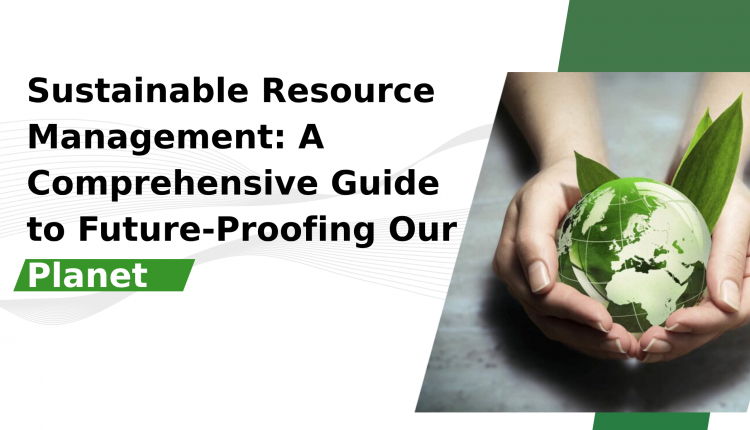Sustainable Resource Management: A Pathway to a Greener Future
A Guide to Building Resilient Systems for Future Generations
Sustainable Resource Management: A Comprehensive Guide to Future-Proofing Our Planet
In the face of increasing environmental challenges and resource depletion, sustainable resource management has become more crucial than ever. This comprehensive guide will delve into what sustainable resource management entails, its importance, strategies, and how it can be effectively implemented to ensure a balanced ecosystem and a prosperous future for generations to come.
What is Sustainable Resource Management?
Sustainable resource management refers to the practice of utilizing natural resources in a manner that meets current needs without compromising the ability of future generations to meet their own needs. It involves careful planning and management to ensure that resources like water, soil, forests, and minerals are used efficiently and responsibly.
The Importance of Sustainable Resource Management
1. Environmental Preservation
One of the primary reasons for adopting sustainable resource management practices is to protect and preserve our environment. By managing resources wisely, we can reduce pollution, prevent deforestation, and combat climate change. This helps in maintaining biodiversity and ensuring that ecosystems remain healthy and resilient.
2. Economic Stability
Sustainable resource management is not just about protecting the environment; it’s also about ensuring economic stability. Overexploitation of resources can lead to scarcity, which in turn can drive up costs and disrupt economies. By managing resources sustainably, we can ensure that they remain available and affordable for future use.
3. Social Equity
Ensuring that resources are managed sustainably also promotes social equity. It helps in providing fair access to resources for all people, including marginalized communities who are often the most affected by resource depletion and environmental degradation.
Key Principles of Sustainable Resource Management
1. Efficiency
Efficiency involves using resources in a way that maximizes output while minimizing waste. This principle focuses on getting the most value out of resources without overexploiting them. For instance, using energy-efficient technologies and practices can significantly reduce resource consumption.
2. Conservation
Conservation is about preserving resources for future generations. It involves practices like protecting natural habitats, reducing waste, and using renewable resources. For example, conserving water through efficient irrigation systems and reducing industrial waste can help in preserving these vital resources.
3. Equity
Equity ensures that resources are distributed fairly among different populations and regions. This principle addresses the needs of various stakeholders and ensures that no group is disproportionately burdened or benefited from resource use. Policies and practices should be designed to balance the needs of all users.
4. Resilience
Resilience refers to the ability of systems to withstand and recover from disturbances. Sustainable resource management aims to build resilient systems that can adapt to changes and shocks, such as climate change or economic fluctuations. This involves creating flexible strategies and practices that can handle uncertainties.
Strategies for Effective Sustainable Resource Management
1. Integrated Resource Management
Integrated resource management involves coordinating the use of various resources (e.g., water, land, and energy) in a holistic manner. This approach ensures that the interconnections between different resources are considered, leading to more sustainable outcomes. For instance, combining water management with land-use planning can enhance both water conservation and agricultural productivity.
2. Adoption of Renewable Resources
Renewable resources, such as solar and wind energy, are crucial for sustainable resource management. Unlike fossil fuels, they are not depleted when used, making them a more sustainable option. Investing in renewable energy technologies can reduce dependence on non-renewable resources and lower environmental impacts.
3. Sustainable Agriculture
Agriculture plays a significant role in resource management. Sustainable agricultural practices, such as crop rotation, organic farming, and precision agriculture, can enhance soil health, reduce water usage, and minimize environmental impacts. These practices also contribute to food security and rural livelihoods.
4. Waste Reduction and Recycling
Reducing waste and promoting recycling are essential components of sustainable resource management. By minimizing waste generation and maximizing recycling efforts, we can reduce the strain on natural resources and decrease environmental pollution. Implementing comprehensive waste management systems can help achieve these goals.
5. Policy and Regulation
Effective policies and regulations are vital for enforcing sustainable resource management practices. Governments and organizations play a key role in setting standards, providing incentives, and monitoring compliance. Policies that encourage sustainable practices and penalize overexploitation can drive positive changes.
Challenges in Sustainable Resource Management
1. Balancing Economic and Environmental Goals
One of the main challenges in sustainable resource management is balancing economic growth with environmental protection. Often, economic activities such as mining or industrial production can conflict with conservation efforts. Finding a balance requires careful planning and stakeholder engagement.
2. Climate Change
Climate change poses a significant challenge to sustainable resource management. Changes in climate patterns can affect resource availability and distribution, making it harder to manage resources sustainably. Adaptive strategies and climate-resilient practices are essential to address these impacts.
3. Overexploitation of Resources
Overexploitation of resources, such as overfishing or deforestation, can lead to depletion and environmental degradation. Addressing this issue requires implementing sustainable practices and monitoring resource use to prevent overexploitation.
Case Studies of Successful Sustainable Resource Management
1. The Sustainable Development Goals (SDGs)
The United Nations’ Sustainable Development Goals provide a framework for sustainable resource management globally. These goals encompass various aspects of resource management, including clean water, affordable energy, and sustainable cities. Many countries and organizations have successfully implemented strategies aligned with these goals.
2. The Forest Stewardship Council (FSC)
The Forest Stewardship Council (FSC) is an example of a successful certification system for sustainable forest management. FSC-certified forests are managed according to rigorous environmental and social standards, ensuring that they are used sustainably and responsibly.
3. The Transition Town Movement
The Transition Town movement is a grassroots initiative aimed at creating sustainable communities. By focusing on local resilience and sustainability, these communities work to reduce their dependence on non-renewable resources and enhance local self-sufficiency.
Future Directions in Sustainable Resource Management
1. Technological Innovations
Technological innovations, such as smart grids and precision agriculture, are paving the way for more effective sustainable resource management. These technologies enable better monitoring, efficiency, and management of resources, contributing to sustainability goals.
2. Collaborative Approaches
Collaborative approaches involving governments, businesses, and communities are crucial for advancing sustainable resource management. Multi-stakeholder partnerships can foster innovation, share best practices, and drive collective action.
3. Education and Awareness
Raising awareness and educating people about the importance of sustainable resource management can lead to more widespread adoption of sustainable practices. Educational programs and campaigns can help individuals and organizations understand their role in resource conservation.
Conclusion
Sustainable resource management is essential for ensuring a balanced and prosperous future. By adopting efficient, equitable, and resilient practices, we can protect our environment, promote economic stability, and ensure social equity. While challenges remain, innovative strategies and collaborative efforts offer promising solutions. Embracing sustainable resource management not only helps in addressing current issues but also prepares us for a more sustainable and resilient future.
This conference, organized by IEREK in collaboration with Polytechnic University of the Philippines, will take place in Manila, Philippines, in April 2025. If you’re interested in exploring topics related to sustainable resource management, such as environmental preservation, economic stability, and innovative strategies for future-proofing our planet, this event is perfect for you. Don’t miss the opportunity to connect with experts, gain valuable insights, and contribute to discussions that shape the future of sustainability. For more details and to register, visit the official conference page. Join us in making a difference!






